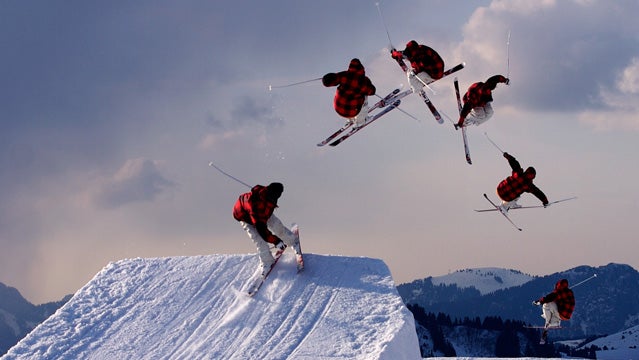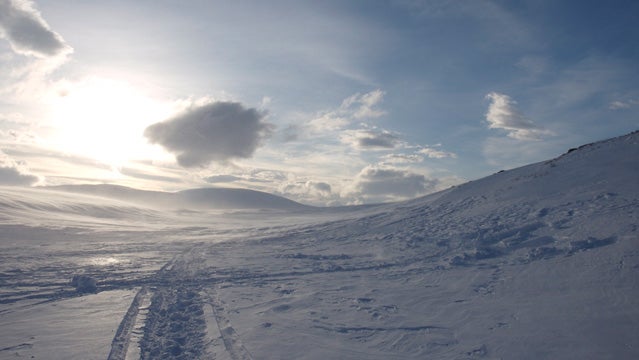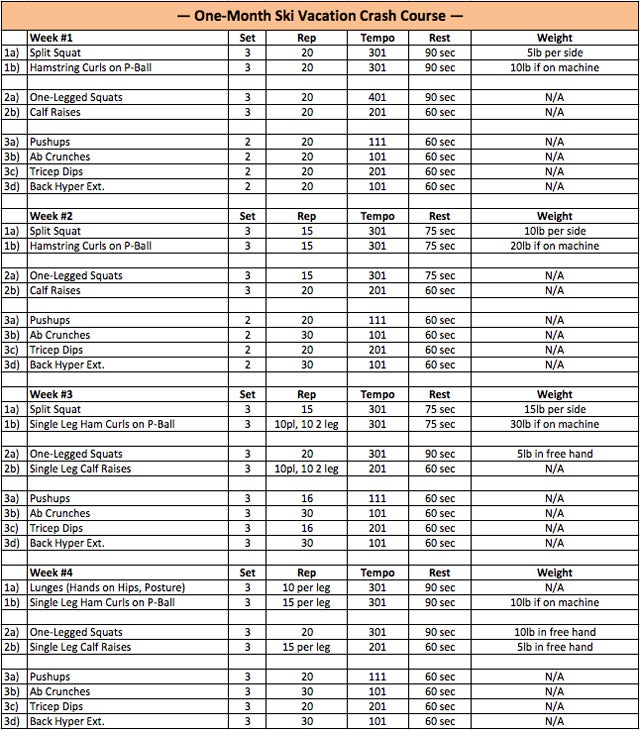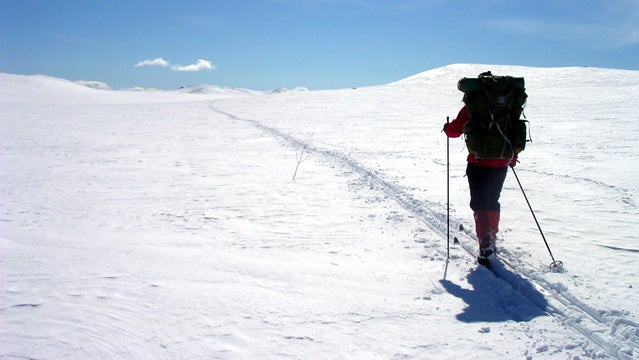Yes You Can: Become a Better Skier in Just 5 Days
ItŌĆÖs the ultimate fantasy. Living in a picturesque ski town, trading beer for a tune-up, and counting 120 days a year on the slopes. But while many skiers dream about bumming it and logging massive vertical in a single season, itŌĆÖs not always possible, particularly if home is miles away from snowy peaks. Fortunately, experts say five days are all it takes to enhance technique and feel confident tackling more difficult terrain.
Training Plan
╠²
ŌĆ£With four or five days of a ski vacation, you can do a lot to turn things around and improve your skiing,ŌĆØ says Reid Phillips, masterŌĆÖs coach at the Vail Ski and Snowboard Club. It just takes planning, dedication, and a little expert help. So bust out a note pad, get amped, and read on for nutrition, training, and vacation tips from the pros, including Phillips and three-time World Cup champ and Olympian Rob Boyd. (Who really does ski 120 days a year. DonŌĆÖt hate.)
Booked the lodge and pre-ordered your lift tickets?
- The Top 10 Tips for Becoming a Better Skier in Just 5 Days
- The Essential Ski Vacation Nutrition Plan
- Our 1-Month Crash Course Ski Vacation Training Plan
The Top 10 Tips for Becoming a Better Skier in Just 5 Days
Even Bode Miller had to start somewhere

Training Plan
The hard part was getting the week off. Now make the most of your time on the slopes by following the expert advice below.
YOUR ADVISORS
Rob Boyd: Three-time World Cup champion, three-time Olympian, current sports development manager for the
Jordan Williams: Coach and dryland coordinator for the WMSC
Reid Phillips: masters coach and ski patroller╠²
10. UPDATE EQUIPMENT
ŌĆ£DonŌĆÖt take your 10-year-old gear and think itŌĆÖll be fine,ŌĆØ Boyd says. ŌĆ£A newer, fresher ski is going to have a little more bounce in it, more liveliness than an older ski.ŌĆØ DonŌĆÖt want to buy? Try demoing some new equipment. And make sure your boots fit well. ŌĆ£Wear them a few hours before your holiday to make sure theyŌĆÖre comfortable,ŌĆØ Boyd says. If your boots are more than five years old or have more than 100 to 150 ski days on them, Phillips recommends updating them. ŌĆ£The newer, lighter weight equipment will make skiing infinitely more enjoyable,ŌĆØ Phillips says.
09. GET FIT
ŌĆ£If youŌĆÖre able to do a ski fitness program beforehand, itŌĆÖll help you take full advantage of the $80 lift tickets,ŌĆØ Boyd says. Forget building to the big stuff if your fitness isnŌĆÖt up to snuff; youŌĆÖll be holed up in the warming hut cursing the groomer that demolished your quads. Follow our one-month crash course in ski fitness, designed to strengthen the areas youŌĆÖll work most: your core and legs. That way when the time comes, youŌĆÖll be physically ready to tackle some epic runs.
08. MAKE A PLAN
ŌĆ£Most people put more time into figuring out where to get dinner each night than planning their ski days,ŌĆØ Phillips says. Big mistake. He recommends outlining what you hope to accomplish by the end of the week so you can build up to it safely. The next bunch of tips will help you design a plan of attack.
07. TAKE IT EASY
ŌĆ£Ease into your ski vacation,ŌĆØ Phillips says. ŌĆ£A lot of people come so amped up to get out there that they crush themselves on the first day.ŌĆØ That means no matter how much those double diamonds or powdery bowls are calling your name, start with the groomers to re-familiarize yourself with your skis, boots, and the feel of the snow. ŌĆ£Challenging yourself with the expert stuff on the first day could make your week trip into a day,ŌĆØ Boyd says. So save the hotdogging for later.
06. BACK AWAY FROM THE POWDER
Yes the fluff is the stuff of skiersŌĆÖ dreams, but it ŌĆ£can spell trouble if you havenŌĆÖt been skiing in quite a while,ŌĆØ Boyd says. ŌĆ£ThereŌĆÖs a number of things that could go wrongŌĆØ in the deeper snow, including knee and shoulder injuries. However, Boyd says, newer equipment will make skiing in powder much easier. If you feel itŌĆÖs entirely blasphemous to avoid freshies your first day out, just be extra cautious.
05. TAKE A LESSON
Sure, it can be expensive, but shelling out for a day or half-day of instruction early on can jumpstart your improvement. Consider the benefits of getting schooled:
Tips: An instructor will tell you what to work on, and explain how to make the most of your new equipment.
Guidance: New mountain? The instructor will know where to go. ŌĆ£Glean as much information from him as possible,ŌĆØ Boyd says. Like where the best mogul, tree, and GoPro-worthy runs are.
Lift line priority: Suckas.
04. DRILL
Just like a swimmer practices high-elbows and bilateral breathing, a skier must drill to improve technique. Boyd recommends finding a mellow pitch and doing , , making short and long radius turns, and identifying your center of balance by making a few turns leaning too far forward, and a few more turns leaning too far back. Once youŌĆÖve got the hang of it, move on to steeper terrain.
03. DRINK WATER
ŌĆ£Back off the alcohol because youŌĆÖre at altitude,ŌĆØ Phillips says. ŌĆ£ItŌĆÖs easy to overdo it the first night when youŌĆÖre 10,000 feet higher than normal.ŌĆØ Drinking alcohol can exacerbate symptoms of high-altitude sickness, including headaches and nausea. If you really want to improve, bust out the bubbly to celebrate a week well skied rather than a successful arrival at the mountain. (We know thereŌĆÖs no way youŌĆÖll waste your trip getting busted for a Ski-UI.)
02. CONSERVE YOURSELF
ŌĆ£When you run out of gas, back off temporarily,ŌĆØ Phillips says. ŌĆ£If you donŌĆÖt have it in the tank, donŌĆÖt push yourself past that point.ŌĆØ Fatigued skiers who keep bombing down the big runs are usually the guys who wind up in PhillipsŌĆÖ toboggan. He recommends ŌĆ£bookending the days you decide to charge with easy days, so when you jump into a double black and you hit the bottom, you say ŌĆśYeah, that felt good!ŌĆÖ instead of ŌĆśGod, I feel like a bag of crap.ŌĆÖŌĆØ
01. HUCK IT
ŌĆ£Of course you want to challenge yourself and have some good stories of survival to tell,ŌĆØ Boyd says. Nobody wants to hear how beautifully you carved the groomers. (They donŌĆÖt want to see it on video either. Trust us.) So warm up, get your snow legs under you, then take the helmet cam down the run youŌĆÖve always dreamed of trying. Your survival will be proof of a ski vacation well spent.
The Essential Ski Vacation Nutrition Plan
Eat right. Ski hard.

Training Plan
ŌĆ£People are usually more concerned with apr├©s ski than they are with getting the most out of their lift ticket,ŌĆØ says Adam Korzun, high performance dietitian for the U.S. Ski Team. ŌĆ£Make the most of it and try to get in as many runs as you can.ŌĆØ HereŌĆÖs how:
BEFORE ARRIVAL
ŌĆ£YouŌĆÖre going to get dehydrated faster at altitude than you would at sea level,ŌĆØ Korzun says. So make sure youŌĆÖre well hydrated before arriving at the resort, then make an effort to stay hydrated while skiing. A simple rule of thumb: Drink when youŌĆÖre thirsty.
BREAKFAST
ŌĆ£Skiing can be very strenuous so itŌĆÖs important to start the day well fueled,ŌĆØ Korzun says. DonŌĆÖt reach for a donut and head out the door. Instead, ŌĆ£get a good balance of carbs and protein,ŌĆØ Korzun says. Try an egg-white omelette with toast, or oatmeal with fruit and eggs. ╠²
LUNCH
What you eat for lunch ŌĆ£depends on how hard youŌĆÖre going. If youŌĆÖre looking to get a lot of heavy runs in, youŌĆÖll burn carbs up fast,ŌĆØ Korzun says. Also, when you come to altitude from sea level, youŌĆÖll burn more carbs faster than normal. So replace them. If youŌĆÖre heading to the lodge for lunch, Korzun recommends staying away from the nachos and burgers and chiliburgers. Opt instead for lighter fare that will replenish carb stores and provide some protein without making you feel sluggish. A peanut butter and jelly sandwich should do it, or just about any type of sandwich, or a bowl of chili.
As for the saucer-sized cookies and brownies and Rice Krispie treats most lodges have, Korzun says heŌĆÖs not opposed to those, ŌĆ£but think about refueling and setting yourself up not just for afternoon runs, but for the next day, too.ŌĆØ That quick rush of sugar may make you feel awesome for a few runs, but youŌĆÖll likely crash hard afterward. Some better snack options: trail mix, Clif bars, or granola bars.
DINNER
ŌĆ£The mindset is often flipped where we go right to the apr├©s ski, forget about refueling, and that compromises you on the next day,ŌĆØ Korzun says. Aim to eat a meal with a 2:1 ratio of carbs and protein before settling down in the hot tub with a glass of wine. A few options: chicken with vegetables and pasta, or stir fry with brown rice.
Our 1-Month Crash Course Ski Vacation Training Plan

Track your workouts, get email reminders, and more by created by Whistler Mountain Ski Club coach and dryland coordinator Jordan Williams. In just one month, you'll be ready to hit the slopes for a five-day vacation that leaves you a much better skier than you've ever been.


